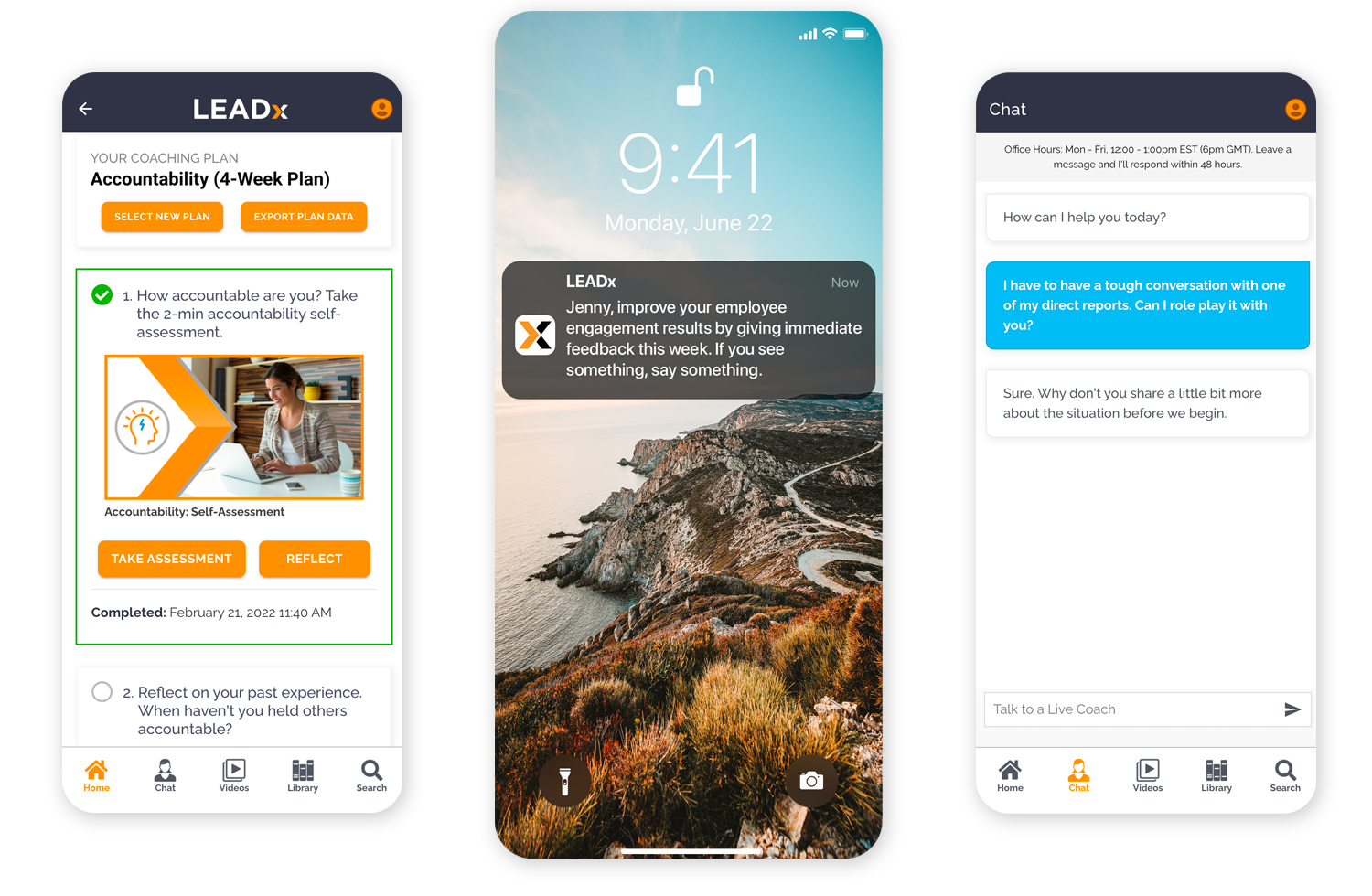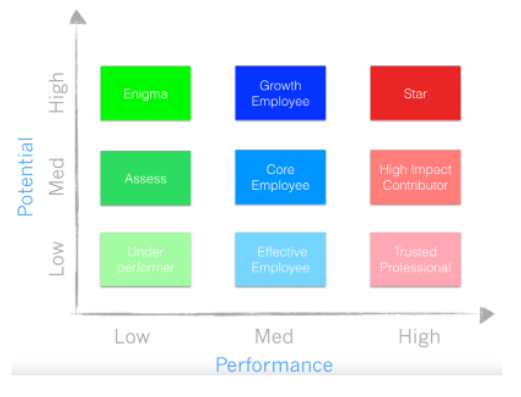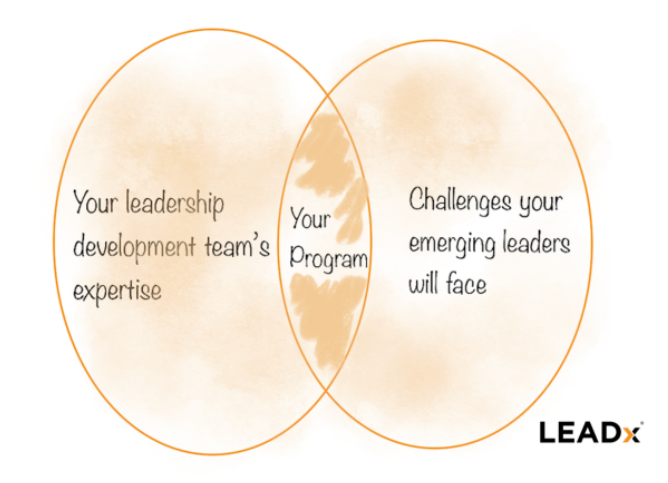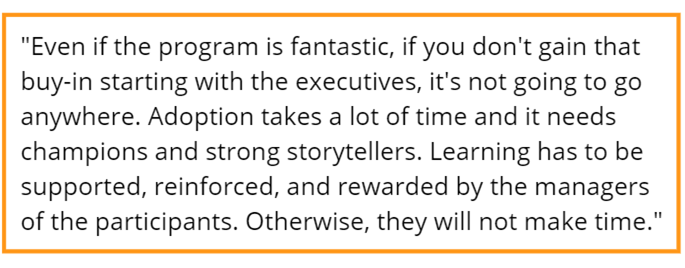
Emerging Leaders Program: The Ultimate Guide
Talent is more important than ever, especially in the age of the Great Resignation. That’s why the best leadership development teams are leveraging emerging leaders programs.
A strong emerging leader program engages, motivates, and ultimately retains talent. Well-trained talent will also hit the ground running once a leadership position opens up, saving time and money on recruitment.
In our work and interviews with highly successful leadership development teams we’ve learned a lot about what makes an emerging leaders program successful. So, whether you’re evaluating an outside program or getting ready to build your own, here are some of the most important considerations to keep top of mind.
What Are the Qualities of An Emerging Leader?
There’s not one best way to determine the qualities of an emerging leader. Some organizations fundamentally believe that leadership training should be available to anyone who wants it, regardless of rank or title. Other companies believe that a selective program drives healthy competition. Even within your organization, some leadership roles require very specific types of expertise that needs to be established and proven before leading; other leadership positions may not. With that in mind, here are three common approaches to consider for selecting emerging leaders.
-
- Self-Selected. Anyone who wants to learn leadership skills can sign up. Self-selection filters for those who are already motivated. An added bonus to this approach is that even those who don’t go on to become “people leaders” will be trained in key leadership skills, making them more effective contributors and team members. This helps create a culture of “leading regardless of title.”
- Manager Selected. Emerging leaders are nominated by their manager to attend. Be careful with this approach. Without clear and rigorous guidance around selection, manager selection can become subjective and biased as managers choose the people they like and the people who are similar to them. The last thing you want is a manager selection process that inhibits diversity and opportunity in your leadership pipeline. Ping Identity’s Champion of Learning, Dr. Jennifer E. Arzberger, describes the benefits of this approach based on her experience designing the EXPLORE program:
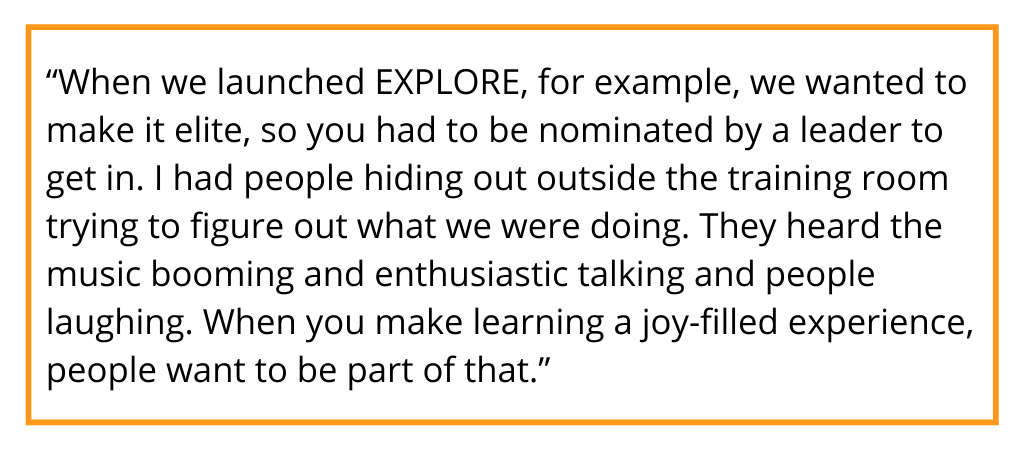
-
- Manager selected, using an approach designed by Leadership Development.
 To address potential for bias in selection, some leadership development teams create rigorous selection criteria and work with managers to help them select employees. A classic example is the nine-box model. Each box has a set of behaviors and outcomes predetermined by the leadership development team. The manager evaluates team members accordingly and makes recommendations. The idea is to invest the most in employees that fall into the upper right four boxes.
To address potential for bias in selection, some leadership development teams create rigorous selection criteria and work with managers to help them select employees. A classic example is the nine-box model. Each box has a set of behaviors and outcomes predetermined by the leadership development team. The manager evaluates team members accordingly and makes recommendations. The idea is to invest the most in employees that fall into the upper right four boxes.
Image Source
- Manager selected, using an approach designed by Leadership Development.
How Do You Develop An Emerging Leader?
Just like there’s no one way to define the qualities of emerging leaders, there’s no one way to train and develop them either.
One big question that’s often raised is whether it’s better to develop emerging leaders in-house or to send them to a program. Outside programs remove the extra time and energy that it takes to build your own program, but long-term, they can become an expensive, ongoing cost. Outside programs also tend to be designed to support a more generic definition of leadership. Developing in-house, on the other hand, can be surprisingly easy and affordable (especially once you’ve put in the initial creation time), and you can tailor your training to the needs of your emerging leaders, your company, and your goals. You can also adjust your approach as you go based on feedback and the changing needs and goals of your company.
In our interviews and work with leadership development teams, we are often surprised by how unique each approach is to in-house programs. For example, Intuit built a leadership playbook for all of their leaders. The playbook took core learnings from training and showed how those learnings could be used to solve typical problems faced by their leaders. And UiPath built a system around “pulses.” By pulsing leaders and their direct reports, they gathered real time, important data about what challenges current leaders faced and how well their training addressed those challenges. The pulses on current leaders allow UiPath to train emerging leaders based on evidence-backed challenges they will face.
The bottom line when it comes to developing emerging leaders in-house versus out, is that while there are some excellent outside programs to enroll leaders in, the advantages of individualizing, tailoring, tracking, and adjusting your program as you go usually outweigh the advantages of outside programs.
One Rule To Keep In Mind as You Develop Emerging Leaders
While the final destination can be approached in a number of ways (as well as in-house or out), it is important to have a formalized approach. Don’t make leaders hack their way through the jungle, figuring everything out as they go. Research shows that an informal approach is actively harmful to emerging leaders. Emerging leaders who didn’t receive formal training felt like they had insufficient training and support to succeed. Worse yet, their energy levels and job satisfaction dropped after being promoted.
There may not be any one approach that works, but here’s one rule to follow as you develop your approach: Get to know the specific challenges leaders at your organization face. Then, apply your leadership development team’s knowledge and expertise to those challenges. This is the leadership development “true north” motto.
Emerging Leaders Program Curriculum
Curriculums for emerging leaders can be broad or narrow in topic, span days or years, and be built in-house or outside. There’s no one way to put together a curriculum. That said, the best curriculums very broadly tend to:
-
- Help emerging leaders prepare for the challenges they will face.
- Help emerging leaders understand core company values and put them to practice.
- Excite and motivate emerging leaders about future opportunities.
 With the above in mind, there are certain topics that come up especially often in the work we do with our clients:
With the above in mind, there are certain topics that come up especially often in the work we do with our clients:
-
- Strengths
- Personality
- Emotional intelligence
- Teamwork and the importance of teams
- Decision making
- Change management
- Time management and productivity
- How to give and receive feedback
- Stress management
- Communication
- Influence
- Conflict management
The image to the right shows the Association of Public Health Laboratories’ Emerging Leader Program. It gives you a sense of potential timing over the course of a year and topic selection for an audience of lab leaders.
Image Source: The Association of Public Health Laboratories (APHL) 2020 Emerging Leader Program.
Below, is an example of how we work with clients as they roll out emerging leadership topics in-house:
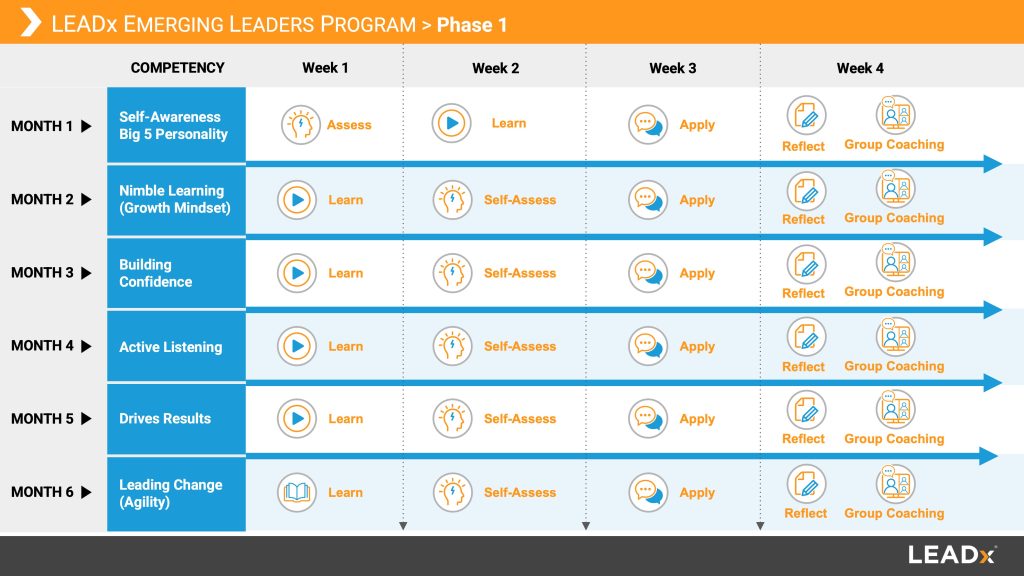
Sample curriculum months 1-6
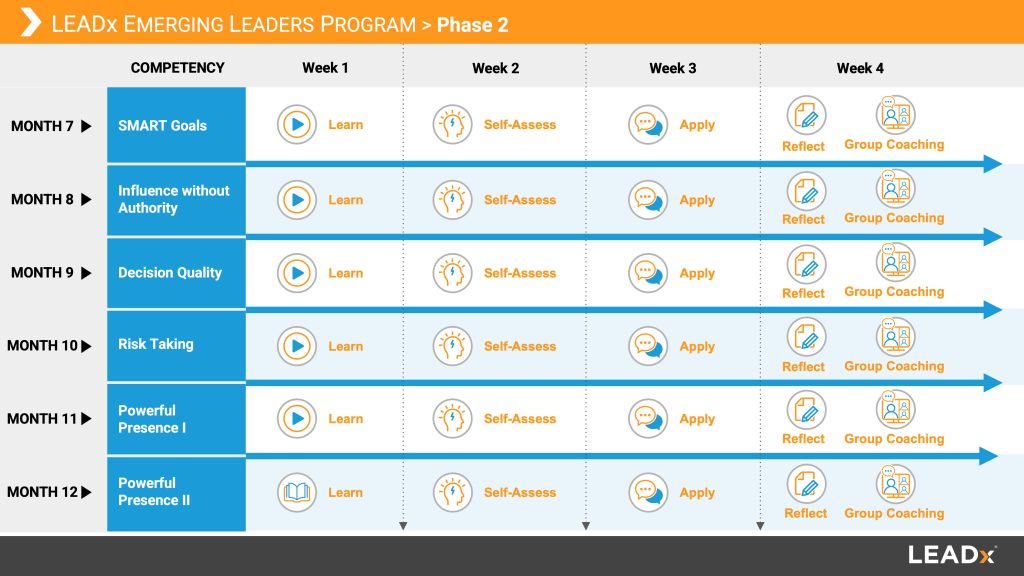
Sample curriculum months 6-12
Avoid These Two Most Common Curriculum Mistakes
Common Emerging Leaders Program Pitfalls and Strategies to Overcome Them
There may not be one way to build an emerging leaders program, but there are certain things to avoid. We’ll call these pitfalls.
The very best programs overcome these three common pitfalls. What follows are descriptions of those pitfalls and proven strategies you can apply to overcome them.
Pitfall #1: Your emerging leaders program doesn’t stick and behaviors don’t change. This tends to sound something like this: “I went through training, but I honestly can’t remember much. I don’t feel like I have time to flip through my workbook and find concepts to practice, so I ended up putting the workbook down.”
Strategies to overcome pitfall #1 and make learning stick: In his book, The Leader Habit, Dr. Martin Lanik describes this pitfall perfectly:

- Hold forums where participants can get together and discuss how a topic applies to their work. Ping Identity does this in weekly TNTs, or “Tuesday Noon Trainings” where people opt in to practice skills together. And Sun Life meets monthly, having participants teach each other how a topic applies to their work.
- Hold clinics where leaders share the challenges they’re facing and leadership development teams coach them through applying what they’ve learned to those problems. Clinics teach people to apply training to a real problem, which research shows is a powerful way to embed learnings in our memory.
- Build a playbook as a resource that shows participants how to apply what they learn to the actual work challenges they face. Playbooks also leverage the power of problem-based learning, serving as an always-available resource for emerging leaders.
- Deliver behavioral nudges that remind participants to practice and apply what they’ve learned.
Pitfall #2: Your emerging leaders don’t see the value in the program: This tends to sound something like this: “I don’t have the time for this training. I’m too swamped by all my current responsibilities!” When people say they don’t have time for training, what they really mean is that it doesn’t seem like a priority relative to their other work.
Strategies to overcome pitfall #2 and show value:
- Change how you use participants’ time. When NextGen Healthcare received feedback from their employees that training was too time-consuming, they didn’t just cut out training. They knew the training was valuable. Instead, they redistributed how participants used their time. They cut back on classroom time and had participants spend 12-16 hours learning online before attending a class. Then, participants used class time for interactive, hands-on work.
- Have leaders emphasize the value. Dr. KimLoan Tran, the Chief Learning Officer of TIBCO describes the power and importance of starting with buy-in from the top:

- Deliver pulse surveys to find out what challenges leaders face. Use the data to show emerging leaders evidence-based value behind your training.
Pitfall #3: You Can’t Get Enough Buy-in, Budget, or Support for Your Emerging Leaders Program. This pitfall is all about failing to prove the business case for your emerging leaders program. With a strong business case, your senior leadership will become advocates and supporters.
Strategies to overcome pitfall #3 and win buy-in, budget, and support:
- Start smaller to show it works. Start with a small group of emerging leaders and prove out valuable metrics. For example, you might track how many emerging leaders successfully moved into leadership roles after one year, or whether your retention of those talented employees improved.
- Start cheaper. Emerging leader programs don’t have to be vastly costly and time-consuming to make a positive impact. Choose important, evidence-based topics and spend your time focusing on application. After enough time has passed to track results, present them to senior leadership.
- Build your case. Show senior leadership the long-term payout of training emerging leaders. Use measures like output, costs, time, job satisfaction, talent retention, and customer satisfaction. Be sure to tell the greater story as well: Training emerging leaders builds skills proactively, creates a program that employees want to be a part of and are motivated to train in, and builds a deep bench of leaders so you will drain less money on recruiting in the future.
Resource for building your case with ROI
How Building A Strong Emerging Leaders Program Can Accelerate Your Career In Leadership Development
At first glance, these potential pitfalls of an emerging leadership program are intimidating, but the truth is, many leadership development teams don’t successfully navigate these pitfalls in any of their programs, let alone their emerging leaders programs.
A successful emerging leader program can help you:
- Earn a seat at the table by showing business impact.
- Positively impact hundreds of emerging leaders’ lives each year (and eventually thousands of people reporting to them).
- Improve retention of talented employees (and eventually of the people reporting to them).
- Positively impact your company culture. Emerging leaders will cast a ripple of behavioral change above, below, and beside them.
If In Doubt, Start By Thinking “Outside-In”
When we interviewed Bettina Koblick the CPO of UiPath, we asked her the one piece of advice she would give to someone earlier in their leadership development career. Here’s what she said:
 What she meant was collect feedback, data, and ideas from employees at all levels, and then build an evidence-based program.
What she meant was collect feedback, data, and ideas from employees at all levels, and then build an evidence-based program.
If you’re overwhelmed and you don’t know where to begin, fall back on this idea of thinking outside in. Conduct a pulse survey and interview managers to understand their challenges. Go back to the venn diagram at the beginning of this article, and ask yourself, “Do I know the challenges my emerging leaders face?”
Once you know these challenges well, building an impactful program will fall into place much more smoothly.


